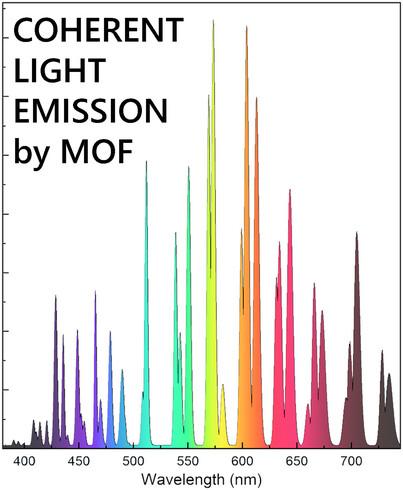Highly Nonlinear Metal‐Organic Framework Microcrystal for Ultrabroadband and Multiwavelength Coherent Light Emission
IF 10
1区 物理与天体物理
Q1 OPTICS
引用次数: 0
Abstract
Nonlinear optical (NLO) crystals are critical for developing coherent light sources that advance fundamental research and technological applications, including metrology, communication, precision machinery, and surgery. While NLO crystals offer unmatched bandwidth and efficiency, their miniaturization contradicts the phase‐matching and crystal size requirements. Here, a non‐centrosymmetric metal–organic framework (MOF) crystal is reported that enables broadband, multi‐wavelength coherent light generation on a microscale. By overcoming the limitations of the most conventional NLO crystals, MOF microcrystal of a fixed orientation supports simultaneously a wide range of NLO effects, initiated by two pump wavelengths in a free space. The second‐ and the third‐order optical nonlinearities in arbitrary direction, coupled with a 1.5 nm

用于超宽带和多波长相干光发射的高度非线性金属-有机框架微晶体
非线性光学(NLO)晶体是开发相干光源的关键,它推动了基础研究和技术应用,包括计量、通信、精密机械和外科手术。虽然NLO晶体提供了无与伦比的带宽和效率,但它们的小型化与相位匹配和晶体尺寸要求相矛盾。本文报道了一种非中心对称金属有机框架(MOF)晶体,它可以在微尺度上产生宽带、多波长的相干光。通过克服大多数传统NLO晶体的局限性,固定取向的MOF微晶体同时支持由自由空间中的两个泵浦波长发起的广泛的NLO效应。任意方向上的二阶和三阶光学非线性,加上1.5 nm3的单元电池和该MOF的巨大超偏振性,同时促进了一组和频产生和级联过程,其跨度超过350 nm,具有7到32个均匀强度的相干峰,质量因子高达180。MOF微晶体的反直觉光-物质相互作用的发现,为小型化光电和通信器件的NLO微晶体的分子设计提供了新的思路。
本文章由计算机程序翻译,如有差异,请以英文原文为准。
求助全文
约1分钟内获得全文
求助全文
来源期刊
CiteScore
14.20
自引率
5.50%
发文量
314
审稿时长
2 months
期刊介绍:
Laser & Photonics Reviews is a reputable journal that publishes high-quality Reviews, original Research Articles, and Perspectives in the field of photonics and optics. It covers both theoretical and experimental aspects, including recent groundbreaking research, specific advancements, and innovative applications.
As evidence of its impact and recognition, Laser & Photonics Reviews boasts a remarkable 2022 Impact Factor of 11.0, according to the Journal Citation Reports from Clarivate Analytics (2023). Moreover, it holds impressive rankings in the InCites Journal Citation Reports: in 2021, it was ranked 6th out of 101 in the field of Optics, 15th out of 161 in Applied Physics, and 12th out of 69 in Condensed Matter Physics.
The journal uses the ISSN numbers 1863-8880 for print and 1863-8899 for online publications.

 求助内容:
求助内容: 应助结果提醒方式:
应助结果提醒方式:


